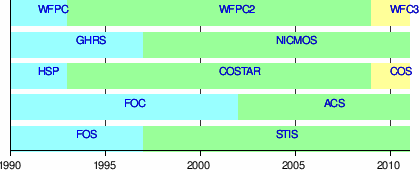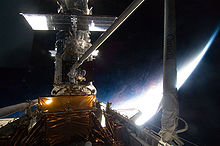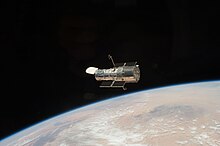Servicing missions and new instruments

Servicing Mission 1
Main article: STS-61
The telescope had always been designed so that it could be regularly serviced, but after the problems with the mirror came to light, the first servicing mission assumed a much greater importance, as the astronauts would have to carry out extensive work on the telescope to install the corrective optics. The seven astronauts selected for the mission were trained intensively in the use of the hundred or more specialized tools that would be needed.[66] The Space Shuttle Endeavour mission STS-61 took place in December 1993, and involved installation of several instruments and other equipment over a total of 10 days.
Most importantly, the High Speed Photometer was replaced with the COSTAR corrective optics package, and WFPC was replaced with the Wide Field and Planetary Camera 2 (WFPC2) with its internal optical correction system. In addition, the solar arrays and their drive electronics were replaced, as well as four of the gyroscopes used in the telescope pointing system, two electrical control units and other electrical components, and two magnetometers. The onboard computers were upgraded, and finally, the telescope's orbit was boosted, to compensate for the orbital decay from 3 years of drag in the tenuous upper atmosphere.[50]
On January 13, 1994, NASA declared the mission a complete success and showed the first of many much sharper images.[67] At the time, the mission had been one of the most complex ever undertaken, involving five lengthy periods of extra-vehicular activity, and its resounding success was an enormous boon for NASA, as well as for the astronomers who now had a fully capable space telescope.
Servicing Mission 2
Main article: STS-82
Servicing Mission 2, flown by Discovery (STS-82) in February 1997, replaced the GHRS and the FOS with the Space Telescope Imaging Spectrograph (STIS) and the Near Infrared Camera and Multi-Object Spectrometer (NICMOS), replaced an Engineering and Science Tape Recorder with a new Solid State Recorder, repaired thermal insulation and again boosted Hubble's orbit.[68] NICMOS contained a heat sink of solid nitrogen to reduce the thermal noise from the instrument, but shortly after it was installed, an unexpected thermal expansion resulted in part of the heat sink coming into contact with an optical baffle. This led to an increased warming rate for the instrument and reduced its original expected lifetime of 4.5 years to about 2 years.[69]
Servicing Mission 3A
Main article: STS-103
Servicing Mission 3A flown by Discovery (STS-103), took place in December 1999, and was a split-off from Servicing Mission 3 after three of the six onboard gyroscopes had failed. (A fourth failed a few weeks before the mission, rendering the telescope incapable of performing science observations.) The mission replaced all six gyroscopes, replaced a Fine Guidance Sensor and the computer, installed a Voltage/temperature Improvement Kit (VIK) to prevent battery overcharging, and replaced thermal insulation blankets.[70] Although the new computer is hardly a powerhouse (a 25 MHz radiation hardened Intel 486 with two megabytes of RAM), it is still 20 times faster, with six times more memory, than the DF-224 it replaced. The new computer increases throughput by moving some computing tasks from the ground to the spacecraft, and saves money by allowing the use of modern programming languages.[71]
Servicing Mission 3B
Main article: STS-109
Servicing Mission 3B flown by Columbia (STS-109) in March 2002 saw the installation of a new instrument, with the FOC (the last original instrument) being replaced by the Advanced Camera for Surveys (ACS). This meant that COSTAR was no longer required, since all new instruments had correction for the main mirror aberration built in.[65]
The mission also saw the revival of NICMOS, which had run out of coolant in 1999. A new cooling system was installed that reduced the instrument's temperature enough for it to be usable again. Although not as cold as its original design called for, the temperature is more stable, in many ways a better tradeoff.[69] ACS in particular enhanced Hubble's capabilities; it and the revived NICMOS together imaged the Hubble Ultra Deep Field.
The mission replaced the solar arrays for the second time. The new arrays were derived from those built for the Iridium comsat system and were only two-thirds the size of the old arrays, resulting in less drag against the tenuous reaches of the upper atmosphere while providing 30 percent more power. The additional power allowed all instruments on board the HST to be run simultaneously, and reduced a vibration problem that occurred when the old, less rigid arrays entered and left direct sunlight. Hubble's Power Distribution Unit was also replaced in order to correct a problem with sticky relays, a procedure that required the complete electrical power down of the spacecraft for the first time since it was launched.[72]
Servicing Mission 4
Main article: STS-125
| Wikinews has related news:NASA launches Space Shuttle Atlantis |
Servicing Mission 4 (SM4), which took place in May 2009, was the last scheduled shuttle mission (STS-125) for the Hubble Space Telescope.[73] The mission was first planned for October 14, 2008.[74] However on September 27, 2008, the Science Instrument Command and Data Handling (SI C&DH) unit on HST failed. All science data pass through this unit before they can be transmitted to Earth. Although it had a backup unit, if the backup were to fail, the HST's useful life would be over.[75] Therefore on September 29, 2008, NASA announced that the launch of SM4 would be postponed until 2009 so the SI C&DH unit could be replaced as well.[76] SM4, with a replacement SI C&DH unit,[77] was launched aboardSpace Shuttle Atlantis on May 11, 2009.[78]
On SM4, astronauts, over the course of five spacewalks, installed two new instruments, Wide Field Camera 3 (WFC3), and the Cosmic Origins Spectrograph (COS). WFC3 will increase Hubble's observational capabilities in the ultraviolet and visible spectral ranges by up to 35 times due to its higher sensitivity and wider field of view. The telephone-booth sized COS assembly replaced the Corrective Optics Space Telescope Axial Replacement (COSTAR) that was installed in 1993 to correct Hubble's spherical aberration problems. (COSTAR was no longer needed after the replacement of the FOC in 2002, the last original instrument without the necessary correction built in.[65]) The COS will do observations in the ultraviolet parts of the spectrum, complementing the measurements done by the repaired STIS system.
The mission repaired two instruments that had failed, the Advanced Camera for Surveys(ACS) and the Space Telescope Imaging Spectrograph (STIS). The astronauts also performed other component replacements, including all three Rate Sensor Units (each containing two gas-bearing gyroscopes); one of three Fine Guidance Sensor (FGS) units used to help keep pointing accuracy and increase platform stability; the SI C&DH unit; all six of the 125-pound (57 kg) nickel-hydrogen batteries used to provide all Hubble's electrical power to support operations during the night portion of its orbit; and three New Outer Blanket Layer (NOBL) thermal insulation protective blankets. The batteries had never been replaced and were more than 13 years over their original design life.[79]
Atlantis released the Hubble Space Telescope on May 19, 2009 back into space after all repairs were successfully made. After testing and calibration, Hubble resumed routine operation in September 2009.[80] These efforts are expected to keep the telescope fully functioning at least into 2014, and perhaps longer.[81]
Hubble was originally designed to be returned to earth on board a shuttle. With the retirement of the shuttle fleet, in July 2011, this will no longer be possible. NASA engineers developed the Soft Capture and Rendezvous System (SCRS), a ring-like device that was attached to Hubble’s aft bulkhead during SM4, which will enable the future rendezvous, capture, and safe disposal of Hubble by either acrewed or robotic mission.[82] The next mission will be to deorbit Hubble at the end of its service life.
Source:
Wikipedia






























No comments:
Post a Comment